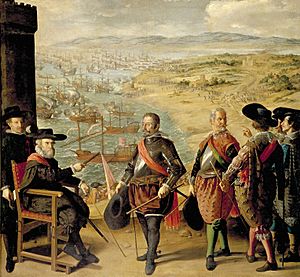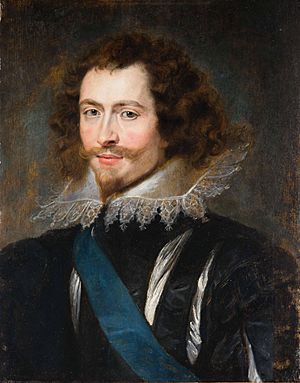Anglo-Spanish War (1625–1630) facts for kids
Quick facts for kids Anglo-Spanish War (1625–1630) |
|||||||
|---|---|---|---|---|---|---|---|
| Part of the Eighty Years' War | |||||||
 The Defence of Cádiz against the English by Francisco de Zurbarán |
|||||||
|
|||||||
| Belligerents | |||||||
| Commanders and leaders | |||||||
The Anglo–Spanish War was a conflict between England and Spain that lasted from 1625 to 1630. England fought alongside the Dutch Republic. This war was also connected to the larger Eighty Years' War between the Dutch and Spanish. Most of the fighting happened at sea, and neither side truly won.
Contents
Why the War Started
During this time, Europe was affected by the Thirty Years War, which began in 1618. This war involved many countries and was often about religion. The Eighty Years' War between Spain and the Dutch Republic also started again in 1622.
Many people in England supported the Protestant Dutch. They were worried about the success of the Catholic Counter-Reformation. However, England's involvement was mostly limited to giving money and sending volunteers. This was because the English King and Parliament disagreed on how to handle the situation.
The Thirty Years War began when Frederick V of the Palatinate, a Protestant, became king of Bohemia. He replaced Ferdinand II, who was Catholic. In 1619, Frederick was removed from Bohemia. Spanish troops then took over his lands in the Electoral Palatinate. This happened as Spain prepared to restart its war with the Dutch. Frederick was the son-in-law of James VI and I, who was king of both Scotland and England.
The War Begins
In 1624, the English Parliament agreed to provide about £300,000 for the war. They wanted this money to be used for a naval war. King James, who preferred peace, refused to declare war. He never did. His son, Charles I, became king and declared war in 1625.
Siege of Breda
In August 1624, the Spanish general, Don Ambrosio Spinola, began a siege of the Dutch city of Breda. The city was very strong and had 7,000 Dutch soldiers defending it. Spinola quickly set up his defenses. He stopped a Dutch army led by Maurice of Nassau, Prince of Orange from reaching the city. In February 1625, another relief force of 7,000 English soldiers was also defeated.
Finally, in June 1625, the city's commander, Justin of Nassau, surrendered Breda to the Spanish. The siege had lasted for eleven months.
Cádiz Expedition
By October 1625, about 100 ships and 15,000 sailors and soldiers were ready for the Cádiz Expedition. England had also formed an alliance with the Dutch. The Dutch sent 15 warships to help guard the English Channel. This was important because the main English fleet was away. Sir Edward Cecil, an experienced soldier, was chosen to lead the expedition. This choice was not a good one, as Cecil knew little about naval matters.
The plan was to capture Spanish treasure ships returning from the Americas. They also wanted to attack Spanish towns. This would hurt Spain's economy and reduce pressure on the Electorate of the Palatinate.
However, the entire expedition was a disaster. The English forces wasted time capturing an old fort that was not important. This gave Cádiz time to prepare its defenses. Merchant ships in the bay also managed to escape. The city's modern defenses were very strong. Meanwhile, some English soldiers who landed further down the coast got sidetracked due to poor discipline.
Eventually, Sir Edward Cecil decided to return to England. His forces were running out of supplies. They had captured very little and had no real impact on Spain. In December, the damaged fleet returned home.
King Charles I wanted to protect his own reputation and that of the Duke of Buckingham. Buckingham had failed to make sure the fleet had enough supplies. So, Charles did not investigate why the expedition failed. Instead, he focused on helping the French Protestants (Huguenots) in La Rochelle. But the House of Commons was not so forgiving. In 1626, Parliament started to try and remove the Duke of Buckingham from his position. To stop this, King Charles I decided to close Parliament.
The failure of the attack had serious effects on England. It caused economic and human losses. It also damaged the reputation of the English Crown. This led to a major political and financial crisis in the country.
Later Years (1627–1629)
The Duke of Buckingham then tried to make a deal with the French leader, Cardinal Richelieu. English ships would help Richelieu fight the French Huguenots. In return, France would help England against the Spanish in the Palatinate. But the Parliament of England was shocked by this idea. English Protestants fighting French Protestants seemed wrong. This plan made them even more suspicious of Catholic leanings at court.
Buckingham later believed Richelieu had betrayed him. So, he formed an alliance with Richelieu's enemies. This included supporting the very Huguenots he had recently attacked. The English forces led by the Duke of Buckingham were defeated by French troops at the Siege of Saint-Martin-de-Ré and the Siege of La Rochelle. In these battles, England lost over 4,000 men out of 7,000.
Dutch Revolt Battles (1626–1629)
After the surrender of Breda, the Dutch army grew to over 61,000 infantry and nearly 6,000 cavalry. Almost 20,000 of these soldiers were English and Scottish. King Charles had sent four English regiments to Holland. Part of this force was sent to the Spanish-held city of Oldenzaal. This city was captured in the summer of 1626 after ten days of bombing.
The next year, English soldiers helped in the siege of the city of Groenlo. A Spanish relief force failed to get through. As a result, the city surrendered to the Dutch commander Frederick Henry, Prince of Orange. In 1629, the important Spanish stronghold of 's-Hertogenbosch was besieged and captured. Frederick Henry's army of 28,000 men, including English and Scottish regiments, took the city.
St. Kitts and Nevis
In 1629, a Spanish naval force, led by Admiral Don Fadrique de Toledo, was sent to the Caribbean. Their mission was to deal with new English and French colonies on the islands of Saint Kitts and Nevis. Spain considered these islands its own since they were discovered by the Spanish in 1498. The English and French colonies had grown enough to be a threat to the Spanish West Indies. In the Battle of St. Kitts, the Spanish destroyed the fortified settlements on both islands and took control of them.
War Ends
England changed its involvement in the Thirty Years War by making a peace treaty with France in 1629. After this, English troops continued to help the Dutch army, but they were paid by the Dutch.
Spain sought peace with England in 1629. This was because of a new conflict called the War of the Mantuan Succession. So, they agreed to stop fighting and exchange ambassadors. On November 15, the Treaty of Madrid was signed. This treaty officially ended the war and brought things back to how they were before the war started.
The war was a very costly failure for England. English merchants lost access to profitable markets in Flanders due to high taxes after the war. The unsuccessful war also made the disagreements between the King and Parliament worse. These disputes had started even before the English Civil War. In fact, the first complaint against Charles I in the Grand Remonstrance was about the high costs and poor management of the 1625 war with Spain.
Images for kids
-
The siege of 's-Hertogenbosch in 1629, by Pieter Snayers
See also
 In Spanish: Guerra anglo-española (1625-1630) para niños
In Spanish: Guerra anglo-española (1625-1630) para niños



